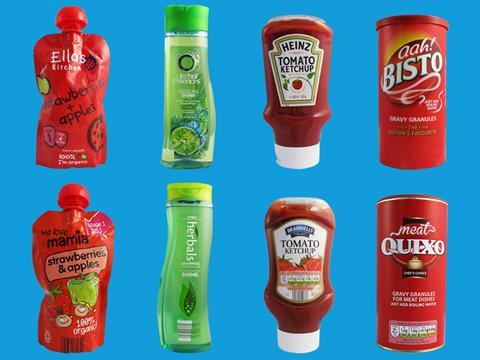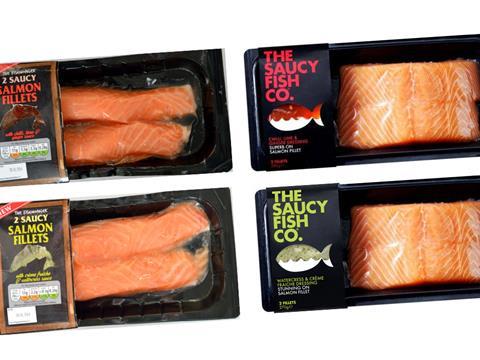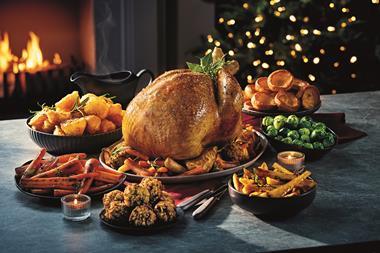
The salmon looked guilty as hell. Accused of impersonating Saucy Fish, Aldi’s version - called Saucy Salmon - was near-identical, from the sleek black vacuum pack, the fish-shaped window on the cardboard sleeve, and the ingredients themselves.
However, this was no mere lookalike, thought Icelandic Seachill, owners of Saucy Fish. It was a doppelgänger: a lookalike carrying a portent of doom - in this case a dramatically lower price point (£4.50 vs £2.99). And Icelandic Seachill wasn’t prepared to see if that 33% discount would eat into its market share. So, just weeks after it launched, it slapped Aldi with a temporary injunction that removed the product from shelves.
“Ghost brands that trade on the halo value of an established brand simply should not be tolerated,” slammed Saucy Fish head of brand Simon Smith, who was relishing the upcoming courtroom showdown, adding: “I’m sure other brand owners will be watching this case with interest.”

He was right about that. Although many supermarkets have been accused of copying brand packaging since the mid-1990s, no one excels, or indeed revels, in impersonating brands quite like Aldi. So schadenfreude filled the air as the case drew near and brands across the UK willed the high-flying German discounter to be shot down.
Instead there was a sense of anti-climax when a deal was struck before the case kicked off and both companies clammed up, citing a confidentiality agreement (although Saucy Salmon is no more. Aldi says it was a trial product that had already been removed from sale.)
Despite the fighting talk in the build-up, seasoned onlookers may have expected nothing less. The out-of-court settlement was just the latest chapter in a series of copycat cases that started strongly but ended with a whimper, despite plenty of senior executives at big brands having nothing but contempt for the practice.
As a “very frustrated” P&G boss Irwin Lee told The Grocer in October: “Suppliers like P&G invest a lot in researching colour, design and packaging. So it’s a free ride for the copycats.”
Threats
The practice dates back to the early nineties, “when supermarkets took their own-label offer from value up to mid-tier,” says John Noble, director of the British Brands Group. “Supermarkets needed to convince consumers they were brand-leading quality so they mimicked the brands to communicate that.”
Yet despite the excess of empirical evidence that a wide range of retailers have ripped off popular packaging, there are a number of reasons why the vast majority of court cases never get before a judge. And reason number one is the inherent symbiotic relationship between brands and retailers. “They can threaten to delist or not supply each other, but that’s not beneficial to either party,” says Chris McLeod, director of trademarks at Squire Patton Boggs. “The brands want to be in the supermarkets and the supermarkets want the brands.”
However, there will always be flare-ups that bring threats of litigation. And currently, when it comes to lookalikes, retailers appear to have the upper hand.
“A shortcoming in the UK legislative framework makes it very difficult for brand owners to challenge the practice,” says Noble. “Retailers say: ‘OK, sue me’, because they know a court case will be extremely difficult for a brand to win.”
It’s not impossible, however. Legally, lookalike packaging is currently challenged on trademark infringement and/or passing off - the latter being legalese for the reproduction of a product in such a way that it confuses a customer to buy a product thinking that it’s another.
In 1990, in what is considered to be the definitive test case for passing off, Reckitt & Colman took on a manufacturer called Borden for copying its Jif Lemon packaging. Reckitt & Colman was successful in its claim. However, the uniqueness of the squeezy lemon packaging set the bar very high for brands following them into court with a complaint over passing off.
As for trademark infringement, perhaps the most infamous example, and the first time a brand versus retailer own-label case made it to court, was in March 1997, when Asda launched a rival to United Biscuits’ Penguin brand and called it the ‘Puffin’.
Like Aldi’s salmon, it was a deliberate dead ringer for its upmarket rival. Under cross-examination, Asda’s then head of marketing for edible grocery, Jonathan Blundell, admitted Asda’s designer was told to “match” Penguin. He also said as the “brand leader” it was “necessary for any packaging of ours to take cues from the Penguin packaging.”
It sounded like an admission, but although the resulting ruling forced Asda to change its packaging it didn’t have to change the name, and the original charge of trademark infringement was dismissed.
“Is a Penguin and a Puffin the same trademark? No, absolutely not,” says Iain Connor, partner at law firm Pinsent Masons.
“If it’s an identical mark and the products are identical that’s a strict copyright infringement,” adds McLeod. “Beyond that, the owner of the registered trademark has to establish the likelihood of confusion. And if the product says Aldi or Sainsbury’s on it, the consumer isn’t going to be confused. That is the issue facing the brand. And the fact brands are rarely successful suggests confusion or misrepresentation isn’t there.”
Indeed, McLeod believes the practice has become so endemic that any attempt to toughen existing legislation would struggle.
“New legislation would be able to catch a brand new product entering the market, but it would need retrospective provisions to ensure a big brand couldn’t immediately sue all the supermarkets when the legislation came into force,” he says.
“You’d also be unravelling decades of a standard practice. Any new legislation that seeks change would have to allow the continuation of existing behaviour, because you can’t say to a retailer ‘next week you’re going to have to stop packaging cola in red.’ Plus lobbying would be aimed at stopping that legislation, or having whatever got through being so weak as to be ineffectual.”
And that won’t help an ongoing situation that brands feel is damaging them. In the December issue of the Journal of Marketing, a paper entitled Private Label Imitation of a National Brand: Implications for Consumer Choice and Law found that “brand imitation harms the imitated brand” due to “loss of market share and the need for the imitated brand to cut its price to maintain it.”
Yet the groundswell of brand indignation could be about to make a breakthrough via an ongoing Department for Business, Innovation and Skills (BIS) consultation, which, if passed, will amend existing intellectual property legislation and offer brands new powers to attack packaging copycats.
“There is an awful lot riding on it and it could go either way,” says Noble. “In 2006, the EU overhauled consumer protection legislation that covered lookalike packaging, but when it was introduced in the UK in 2008 the government said the only ones that could enforce it were the OFT and Trading Standards. But the OFT said it had bigger priorities and Trading Standards said it didn’t have the resources to enforce it either.”
That left the new legislation hamstrung. However, Noble believes if the amendment is passed it will send a “really loud warning shot across the copycats’ bows. They will be up against bigger guns than they were before. I don’t think this will open the floodgates to litigation, but it could be a game-changer in terms of giving a wake-up call to the retailers. And I think a couple of cases to test the law would follow.”
So is it likely to be passed? A decision is set for “early 2015” according to a BIS spokeswoman. And certainly the majority of the MPs involved in the debate sound determined to make it happen.
“There was a time when supermarket own brands were regarded as a cheap replacement for other goods,” says Jim Dowd, MP for Lewisham West and Penge. “That time has passed. The big four supermarkets have a sufficient reputation that people will trust their name on a product. It does not need to look like anybody else’s to sustain custom. Of the new entrants to the market - I will mention this company because it is perfectly true - the biggest offender is Aldi. It is clearly running a systematic campaign to provide products that mislead people into purchasing them.”

The Jif Lemon precedent
Some 25 years ago, what is now considered to be the test case for copycat packaging took place. Jif, owned by Reckitt & Colman, took on rival manufacturer Borden, which had started to produce lemon juice in a squeezy plastic lemon. Jif won, after the judge ruled it had proved the all-important three-part test (reputation and goodwill, misrepresentation, and damage) to prove its claim of passing off against Borden. The judgement was also upheld on appeal. Yet while the case can be seen to offer encouragement for brands who feel their packaging has been blatantly ripped off by a competitor, be it rival brand or retailer, it set a tough act to follow as the squeezy lemon was “genuinely innovative,” says Iain Connor from Pinsent Masons. “And one of the challenges for brands is that packaging is quite generic.”
Smoke and mirrors
“I think that’s extreme,” argues Vicky Bullen, CEO of design agency Coley Porter Bell. “I wouldn’t go as far as that. And when you think about Aldi, there is rarely a branded product for them to mislead against. It’s always about saying ‘We are as good as.’”
It’s also acting within the law. Aldi - and Lidl’s - sales figures suggest customers are only too happy to spend their money on discounter own-label imitations. And a quick glance at the pricing suggests a reason why. Take the four brands featured in the main image (previous page), which cost a total of £7.95 at Sainsbury’s. At Aldi, the imitations cost £3.02 - that’s 62% cheaper.
Aldi insists it is doing nothing wrong. “Consumers are savvy and shop based on value and it is well established that there are generic visual cues on packaging that are useful for consumers - and are legal,” says Giles Hurley, Aldi’s joint MD of corporate buying. “Aldi invests in creating attractive packaging that is unique to our products. Far from confusing customers, we are championing them by providing choice and competition.”
That doesn’t wash with Noble. “If Aldi is conveying category cues, then we have no issue. A blue cap to indicate full-fat milk, for example, is a category cue. Where we do have an issue is that they are not taking the category cues, they are taking the brand cues. And that is misleading. Copying in this way doesn’t add anything new to consumer choice. It certainly doesn’t encourage innovation. Indulging in smoke and mirrors to hoodwink and dupe consumers is deplorable.”
So are consumers really being confused? In November consumer champion Which? said 23% of the 7,855 members it questioned had mistakenly purchased an own-label product instead of a brand because of similar packaging. However, Connor suggests one reason the discounters are doing so well is precisely because consumers are happy to be offered a lookalike for less.
“Consumers just want cheap. And a lot of the lookalike products are perceived to be as good as the brands by consumers. This whole issue creates tensions among the triumvirate of brand, retailer and customer. The brands say the lookalikes are confusing customers, while the retailers are saying they just want cheaper products. And in my opinion, the consumers are probably siding more with the retailers.”
He also argues that brands could fight back harder than they do. “If Heinz took its tomato ketchup off the shelves of every retailer in the UK, all retailers would stop selling an own-label product that aped Heinz because their customers would demand it. So brands have got to be bold, have conviction and take the retailers on.”
Like the British Brands Group, Connor also calls for the BIS consultation to allow brands or individuals to sue under consumer protection legislation. “It is legislation we are already aware of, we understand it, we can apply it with ease and certainty and it adds to passing off, which is a difficult area. It would be a good tool and it would allow both sides to set standards.”
Missing a trick
Whatever happens, Bullen, who works with a wide range of fmcg clients and retailers including Tesco, Morrisons and The Co-op, says being a copycat is already dying out. “Retailers would be stupid to continue with it,” she says. “Own label is an opportunity to build brand equity, a key weapon in their armoury to create distinction and differentiation. When we have been briefed by retailers recently it hasn’t been about copycatting at all.”
That wasn’t the case 20 years ago, she adds. “I remember being told by a large biscuit manufacturer that they wanted packaging for Lidl to be an absolute copy of their brand. I was horrified by it. But it’s a very different brief now among the top five.”
However, she concedes it’s a different story with the discounters. “There are so few brands in store they are crossing the visual equity boundaries on a regular basis, but there are places where it is perfectly sensible for them to use category cues.”
She also thinks Aldi and Lidl will “have to” move away from lookalike packaging as they continue their ongoing evolution. “They need to build their own brand equity. And own label is such an important vehicle to communicate that. So right now they are missing a trick.”
However, private label specialist Koen de Jong says the discounters show no sign of stopping yet. “Take Saucy Salmon,” he says. “Aldi went as close as they could. And even though they came close to getting in trouble, they will continue. Not just because lookalike packaging draws in shoppers, but also because it creates publicity and exposure in the press. So they love it. And they will continue to get as close as they can.”

A brief history
1990: Jif Lemon (left) proves its case of passing off against Borden
1994: Coca-Cola erupts when Sainsbury’s pinches its packaging, plus 15% of the cola market compared with the 3% it had before. The case is settled out of court
1994: Unilever takes on Tesco over its imitation of I Can’t Believe It’s Not Butter called Unbelievable
1994: The IGD develops a voluntary code of conduct to stop copycats
1996: Kellogg’s takes on Tesco over a range of own-label cereal
1997: United Biscuits sues Asda over its Penguin rip-off, the Puffin
2003: Walkers attacks Tesco over its range of Temptations, which ape Walkers Sensations
2009: Diageo takes on Sainsbury’s after the supermarket launches a Pimm’s-a-like ‘Pitchers’
2014: Saucy Fish goes to court with Aldi over Saucy Salmon but the case is settled out of court



















No comments yet